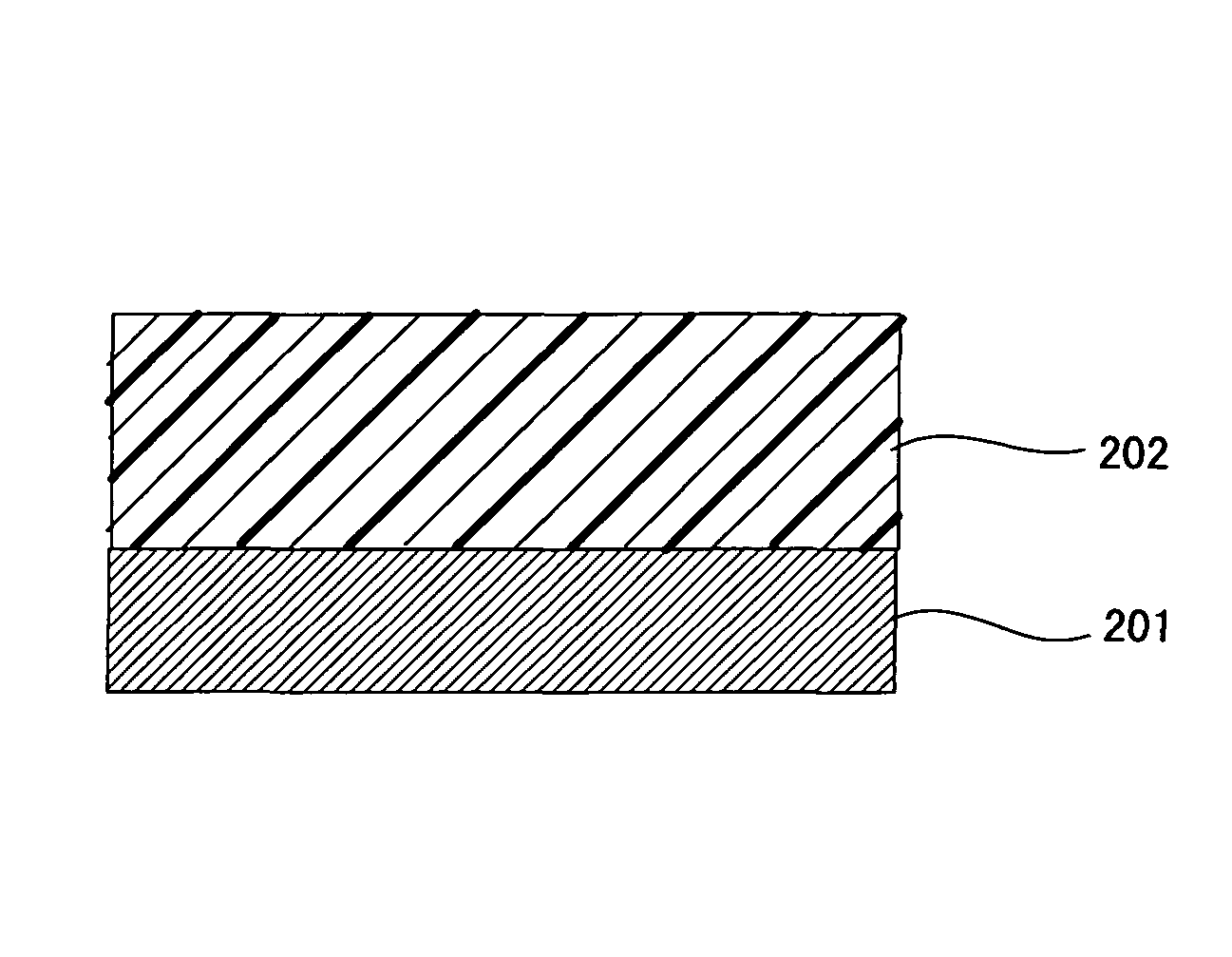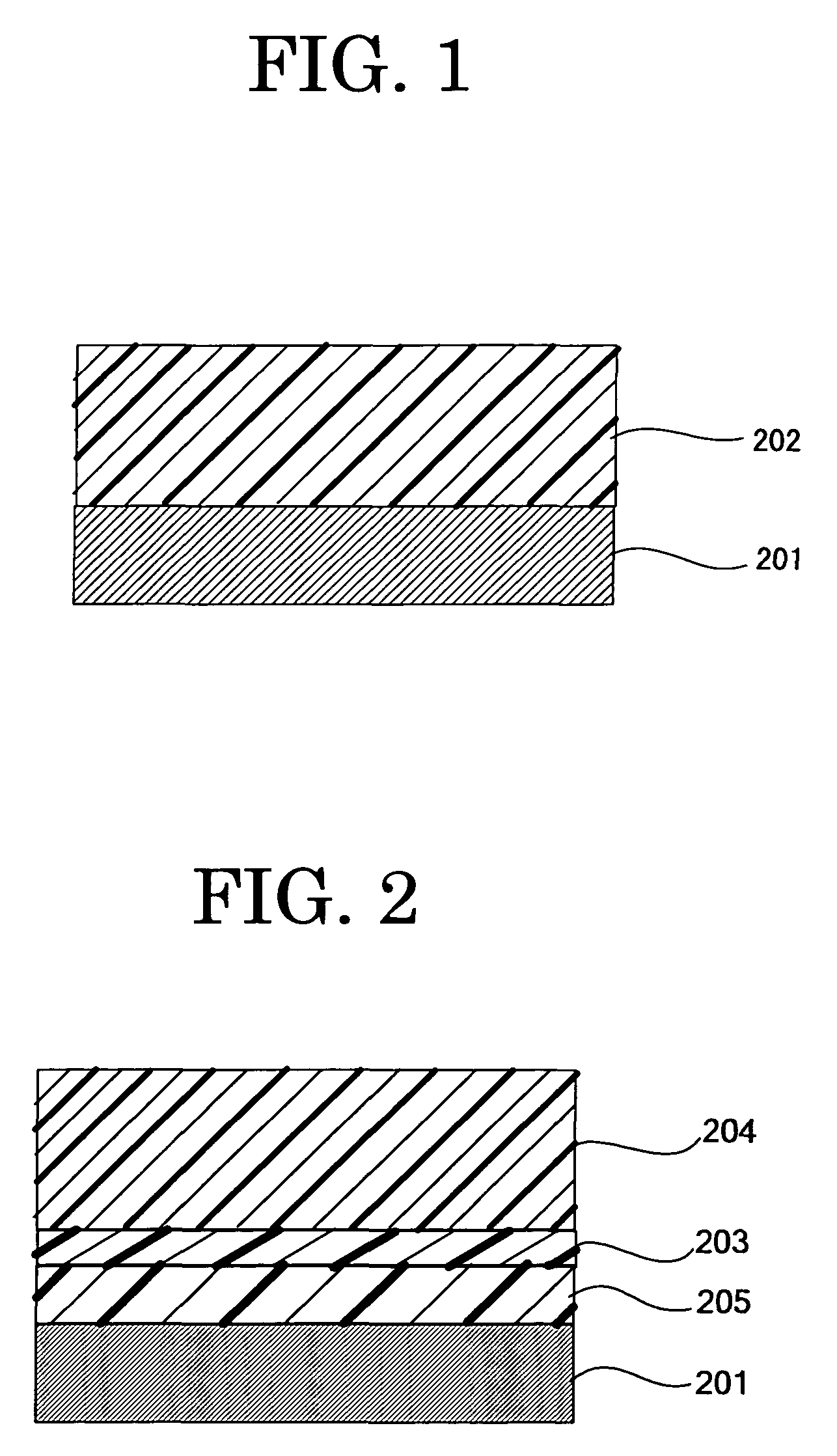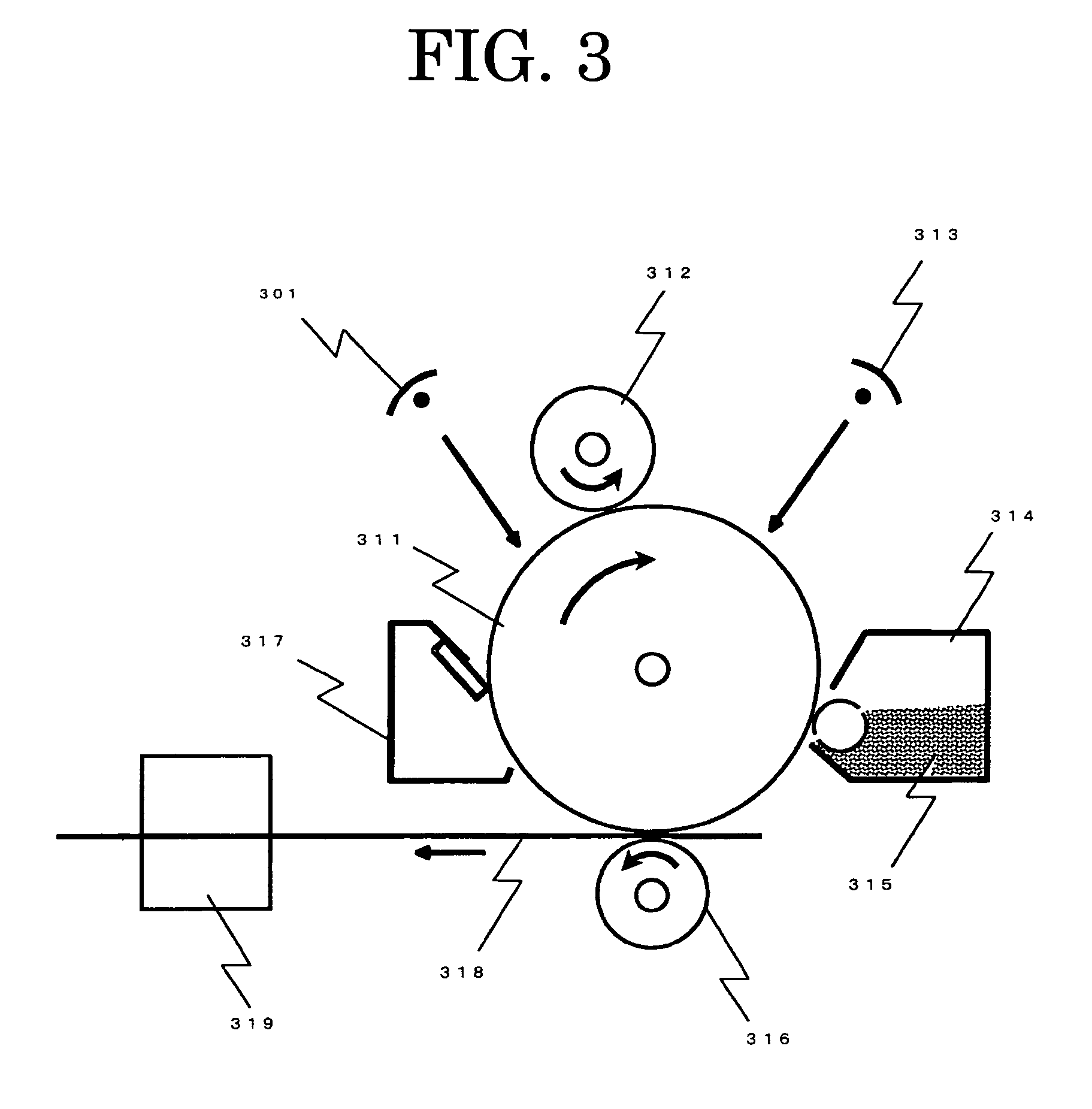In contrast, the multilayer photoconductor is mostly of negative charging type and the multilayer photoconductor of positive charing type has not been put to practical use.
This is because the
electron transporting material which excels in
electron transporting function, is less toxic and highly compatible with binder resins has not been put to practical use.
Although single-layer photoconductor in general has bipolar sensitivity of negative and positive, most of them are used for positive charging because
electron transporting material has low transportability of electron.
Generally, the transfer
voltage is not applied to the photoconductor directly but through a transfer medium (paper) and it is not applied until the transfer medium passes through the transferring step, however, controlling ON / OFF timing of transfer
voltage is difficult and in some areas of anterior and rear ends of the transfer medium, transfer
voltage is often applied directly.
However, when negative polarity sensitivity of the positive charging single-layer photoconductor is inappropriate (
electron transporting material has low electron transporting function), negative
space charge is not erased sufficiently, and lowering of
electric potential is induced by the effect of
space charge even the photoconductor is positively charged in the next charging step.
However, when the polarity sensitivity of opposite charge of the positive charging single-layer photoconductor is inappropriate,
space charge density of opposite of the charge polarity in the area where image is exposed is increased more than in the area without
exposure, lowering of electric potential occurs in the next charging step and image degraded by image
exposure tends to occur.
When the single-layer photoconductor is used in the image forming apparatus which does not include charge removing step, the
density difference between exposed area and non-exposed area in the image degraded by image exposure becomes further notable because the photoconductor surface is not exposed uniformly.
However, in any of the techniques, electron transporting function of the
electron transporting material is not sufficient and resulted image defects by transfer and image exposure are not sufficiently prevented.
However, transfer units of complicated mechanisms are required, and compactification or cost reduction may be difficult,
transfer efficiency of the toner may be deficient, and dust may be generated in transferring of the toner, thereby being insufficient as fundamental techniques for preventing image degraded by transfer.
As described above, satisfactory result for the technique for preventing or reducing image defects caused by transfer and exposure of the electrophotographic photoconductor having bipolar optical sensitivity of positive and negative has not been obtained in the present circumstances.
However, because properties of such spherical toner of the small
diameter notably changes on the photoconductor and tend to cause cleaning defects, and the like, it is a contributing factor for
image degradation due to toner filming or fusion and also is an important problem.
And because the same problem also occurs in the positive charging electrophotographic photoconductor, a photoconductor which has high tolerance to
image degradation due to toner filming or fusion without causing cleaning defects even when a spherical toner of small
diameter is used in the positive charging electrophotographic photoconductor is needed.
In this image forming apparatus, however, direct voltage of −200V and alternating voltage of
sine wave of 1,800 Hz frequency and 2 kV voltage between peaks are needed to be superimposed in order to perform
charge injection because it has OPC photoconductor of negative charging type and positive charging cannot be performed.
However,
charge injection to the OPC photoconductor to which a charge injecting layer is disposed on its surface is only exemplified by applying a direct voltage of −700V, and there is no example of positive charging for this charging device.
However,
charge injection of −680V is only exemplified by applying a
DC voltage of −700V from the charge bias power source, and there is no example of positive charging for this image forming apparatus.
However, in this
color image forming apparatus, image blur tends to occur during repetitive use in high temperature and
high humidity environment because of the surface protective layer having
diamond carbon structure containing
hydrogen or non-crystalline carbon structure and in addition,
ozone tends to occur because it is charged at −500V by charge injection.
The charge transporting agent for electrophotographic photoconductor has a problem of slow sensitivity when a sensitivity of the multilayer electrophotographic photoconductor is measured by positive charging.
Since the charging ability of the photoconductor is gradually degraded or electric potential of the exposed area is increased due to repetitive cycle of charging and exposing for extended period, sufficient electrostatic contrast for forming a latent electrostatic image cannot be obtained.
Even though initial properties are appropriate, when electrostatic fatigue of the photoconductor is added in the repeatedly performed electrophotographic process, sufficient properties cannot be obtained with the photoconductor in which conventional charge transporting material is used.
Another contributing factor for determining durability of the photoconductor includes wear of the photoconductor with time.
This is because the photoconductor is gradually degraded and becomes worn by receiving mechanical and chemical influences in repetitive steps of charging, exposure, developing, transferring and cleaning in the electrophotographic process.
As wear of the photoconductor is progressed, it leads to lowering of charging ability and causes degraded images.
Even though
wear resistance is improved by these proposals, electric potential of the exposed area is increased due to repetitive use of the photoconductor for prolonged period and
image degradation such as lowering of
image density occur.
Furthermore, although
wear resistance of the protective layer is improved due to high
mechanical strength, when a foreign material is attached on a photoconductor surface for some reason, scratch tends to occur, causing image defects and it may be difficult to be used in the electrophotographic process.
By contrast, removal of toner on the photoconductor is difficult due to
small particle diameter of the toner and in addition, unremoved toner on the photoconductor tends to be fixed on the photoconductor.
When these phenomenon occur, output image is degraded and so-called image defects occur.
However, if the cleaning condition is improved more than is necessary, cleaning defects may occur at an early date, often causing image defects adversely because of abnormal wear or more roughened surface of the photoconductor.
However, if a thick
yarn is used to form a cutpile
brush, an edge of the fracture cross section comes in point-contact with the photoconductor, the surface of the photoconductor is scratched and abnormal wear occurs leading to image defects.
Moreover, when the cleaning condition is improved more than is necessary, scratches caused by repetitive friction is increased and problems of various image defects caused by the scratches occur such as streak defects caused by residual toner after transferring which slips through the scratched part in the cleaning unit or microscopic spotty defects caused by toner particles which get into the scratched part and become fixed, for example.
These image defects tend to increase when the toner of
small particle diameter which is being increasingly employed for the purpose of achieving higher
image quality, particularly when spherical toner such as
polymerization toner is used and it had been extremely difficult for simultaneous pursuit of images of high quality without occurrence of image defects, and high durability for maintaining images of high quality.
However, the image forming apparatus of high
image quality and durability has not been obtained because it was impossible to fulfill these requirements.
There are problems in this type of manufacturing method of the toner such that the particle diameter distribution tends to cover a wide range and fine and coarse powders must be removed by classification for obtaining duplicated images with an appropriate resolution and tone, resulting in very low yield.
To solve the above problem, measures as disclosed in JP-A No. 9-222750, for example, have been taken, but they are not necessarily sufficient.
When the
electron transporting material is used, a problem arises such that the carrier mobility is lower than that of the hole transporting material.
In order to solve the problem of the charge transporting material, the use of predetermined charge transporting material has been proposed in JP-A Nos. 1-206349 and 5-142812, however, a problem arises in terms of compatibility with the binder resin.
This is because the charging ability of the photoconductor is gradually degraded or electric potential during exposure is increased due to repetitive loads added by each unit such as charging and exposing, etc. and sufficient electrostatic contrast for forming a latent electrostatic image cannot be obtained.
When this method is employed, however, problems such that the circularity of the drum is changed or runout accuracy is degraded arise due to force added when the
flange is mounted.
Furthermore, fixation of the
flange by using an
adhesive bond which has been operated conventionally also causes a
slight change in accuracy of the
flange joint due to contraction or expansion generated during fixation of the
adhesive bond.
Other than this,
resonance generated during charging or frictional
noise caused by contact with the cleaning member have also been a problem.
However, when direct voltage superimposed with alternating voltage is applied to the charging member,
noise problem caused by annoying charging
noise generated during charging arises other than ozone and
nitrogen oxide which cause
image quality degradation.
This charging noise is not generated with direct voltage, and it is a unique phenomenon related to oscillating current and as the amplitude increases and the material of the support in the photoconductor transmits more sound, charging noise increases.
Therefore, it is desirable to set the condition so as to lower the noise as much as possible, however, the condition will be toughened as charging stability is increased, resulting in an increase of charging noise, and it is indispensable to take measures to solve above noise problem.
Though the charging noise is improved in the contact charging, it may not be as effective in noncontact charging in which the charging member is arranged to be close to the photoconductor.
For example, sufficient effect are not likely to be obtained by a method in which charging noise is suppressed by the charging member or just by thickening the support in the photoconductor.
The method in which the sound (noise) is suppressed by inserting a filling material inside of the support in the photoconductor may be effective, however, when a space still exists between the support and the inserted material after
insertion, expected effect is not likely to be obtained when the weight is small.
In addition, frictional noise or fluttering noise generated by a member which comes in contact with the photoconductor such as cleaning blade has also been heard during rotating of the photoconductor.
A method in which sound (noise) is suppressed by inserting a filling material inside of the photoconductor and increasing the
mass as described above has been employed as a measure to this kind of the problem, however, slight degradation of the photoconductor accuracy is unavoidable as described above and therefore, it is not satisfactory for fulfilling the increasing demand of higher image quality in recent years.
However, the tandem type also has
disadvantage in terms of size of the apparatus which grows in size because image forming elements are arranged in plural numbers, thereby making it costly.
 Login to View More
Login to View More  Login to View More
Login to View More 


